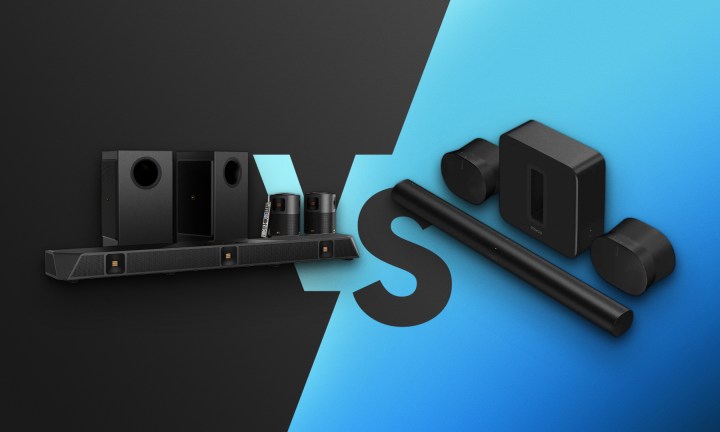
What happens when a $2,600 Sonos system does battle with a $3,900 fire-breathing Dragon? You’re about to find out.
But first, an apology of sorts. This comparison has been a huge undertaking. Moving nine fairly heavy pieces all around our new studio, getting them hooked up, recalibrating them each time I moved them (more on that in a moment) has been a lot of work.
There was a point at which I wondered why I was even doing this. Who out there is actually having a hard time deciding between an absolute monster of a system like the Dragon and a lifestyle system like the Sonos? Well, the answer to that question is quite a few of you, based on the comments and DMs I get. So this is for you.
And in the end, I’m glad I did it. I’ve learned a lot about how systems like these actually pull off Dolby Atmos. And I’ve gained a new perspective on how flexible and convenient Sonos gear actually is, now that I’ve had to move locations, change routers, and get everything all up and running in two different testing locations. Ultimately, this comparison is fairly simple and straightforward, because after using and listening to both of these systems for a few days, this is a pretty clearcut situation.
Value for money
Let’s start with cost, which I’ve already alluded to. The Nakamichi Dragon costs $3,900 — that’s following a $500 price hike after it was first offered. The Sonos system — comprised of one Sonos Arc soundbar, plus one Sonos Sub and two Era 300 speakers — comes in at $2,600. If we were to add another Sonos sub so that we had a dual-subwoofer situation similar to what Dragon offers out of the box, the price would leap to $3,400, which is much closer to the Dragon’s current asking price.
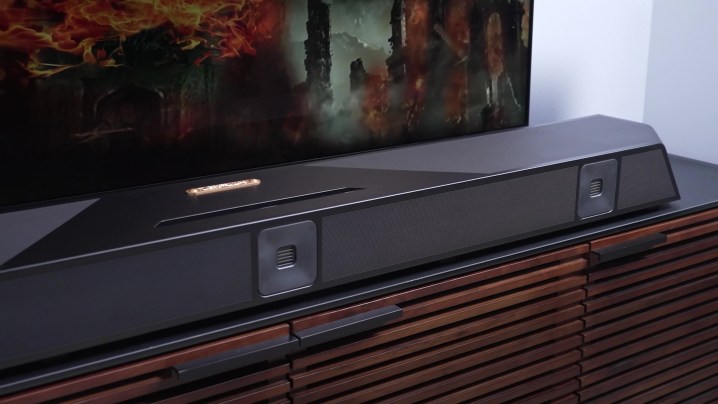
I am a real ROI kind of guy — except I hate saying ROI (only slightly less than having to spell out “return on investment”). I think that if you pay significantly more, you should get significantly more. But then there’s that thing about the law of diminishing returns and, let’s be honest, the whole pay-more-get-more thing doesn’t always play out in the audio world.
With that in mind, the Dragon is kind of … special. It’s an overbuilt tank of a system. It comes in a monster-sized box that is expensive to ship. It’s expensive to make because so many pieces are customized and not produced at scale. A lot of its cost comes from the fact that it is unique and, as a result, no infrastructure exists to make them at scale and at a lower cost.
Also, there’s a little bit of a collector’s piece vibe going on with the Dragon. Not a lot of them are made, not a lot of folks will have one. You get the idea.
If the Dragon is big and brawny, the Sonos is smooth and sexy.
Meanwhile, the Sonos system is the exact opposite of all the things the Dragon is. If the Dragon is big and brawny, the
Honestly, outside of the fact that both of these systems are designed to make movies and music sound awesome, there really aren’t that many similarities.
Maybe it’s my unique view of the world, but I don’t see folks who love Sonos being wooed by the Dragon. Likewise, I don’t see many folks who want the Dragon wondering if they should really go for the
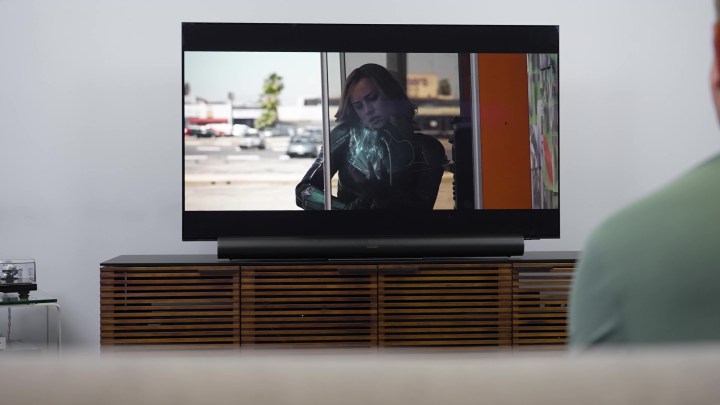
And, yet, I have seen people wondering if they should ditch their aging Sonos system for a Dragon, or upgrade their
Now, let’s get down to some brass tacks.
Setup and use
The Nakamichi Dragon requires a little bit of work just getting it out of the box and placing each component, but from there, you can be up and running with everything sounding awesome in a matter of minutes. Nakamichi has built in a number of room-configuration presets and EQ presets for movies, music, sports, and games. Most of this stuff is available on the remote, so with a few clicks, you are enjoying the system, and it will sound great right out of the box.
However, if you like to get into it and tweak things, then very granular controls are also available – more than when I originally tested it, in fact! Since I put out my review of the Dragon, Nakamichi took some of my feedback and made some changes. For instance, there is now an LFE trim option – though I would love to see a boost option as well – and the speaker distance section is now broken down from whole feet to fractions of a foot. Honestly, I don’t know how much of a difference this actually makes in time alignment, but I’m not gonna lie – I just like being able to be exact with my settings, so I’m glad it is there now.

The Sonos system makes setup pretty easy with its app, but there’s no getting around the fact that it is more involved. You have to connect each speaker to Wi-Fi, and each speaker needed an update this time around, so I had to wait for that before I could move on to connecting the next speaker. The whole process took a while. And then you can run TruePlay, which is Sonos’ tuning system that uses your phone (or, now, the speakers themselves) to optimize the levels of each channel. The end result is really good, but if you’re looking to adjust individual channel levels or customize the EQ, that kind of tweaking isn’t available. Now, it can be argued it isn’t really needed, but just as some of us like to see speaker distances broken down to the decimal, some of us really want to have some level of EQ control. If you’re a control freak – which I totally can’t relate to at all – then the
In my review of the Sonos Era 300, in which I reviewed one of them on its own, two of them as a stereo pair, and both of them as part of a surround system, I talked up the flexibility of being able to use the Era 300 elsewhere in the home as part of a multiroom audio system, in addition to them being able to serve as surround speakers. They also support Bluetooth, so you can use them just about anywhere without needing to use Wi-Fi. All of that is true, they can do that, and that kind of flexibility isn’t something the Dragon can offer.
I’d be inclined to just dedicate the Era 300 as surround speakers and leave them there.
However, as I’ve learned throughout the testing I did for this article, breaking the Era 300 away from the surround system to be used on their own is not exactly a quick process. Plus, if they’ve been tuned to work as your surround speakers, then you might want to retune them to serve independently in their own rooms, meaning you might want to run the TruePlay tuning process again, which is even more time spent if you want the Era 300 to play a multifunction role in your home. Frankly, the Era 300 are sort of overqualified as surround speakers except for the fact that their Atmos contributions as surround speakers is well above anything else Sonos makes. So, I guess what I’m saying is that the notion of flexibility doesn’t play out in real life the way it comes off conceptually. I’d be inclined to just dedicate the Era 300 as surround speakers and leave them there. And that takes a little bit away from what I thought might be an advantage for the
The Sonos system doesn’t let you control how you play back two-channel sources. What I mean is that it is always upmixing it to a surround presentation. And I don’t know about you, but sometimes I just want all channel stereo, or maybe even just two channels and a sub when I’m playing back stereo content, specifically music. That’s something the Dragon system makes easy — you can choose to go native and just play back through the left and right channels of the soundbar. Or you can choose the studio setting, which repurposes the Atmos channels in the soundbar to enhance the left and right speakers. Or you can go all-channel-stereo. Or you can let it upmix to surround sound. In terms of how you play back your media and control how it sounds, the Dragon is actually more flexible.

So, just a recap of where we’re at so far before we get into sound quality differences, which is what I think you’re all anxiously awaiting: The Dragon is big, brawny, and makes no apologies for what it is. You need a custom wall mount and custom speaker stands for the surrounds. It comes with two large subwoofers that you’ll need space for. It’s just a loud and proud system. It’s got a lot of playback and listening options, plus it has granular controls. It’s basically the closest to an AVR and speaker system that we’ve seen from a one-box home theater yet.
The Sonos is more of a sleek and sexy lifestyle system. It looks really good in modern homes, it offers a lot of flexibility, even if it makes you work a bit for that flexibility, and while it may not offer a lot of granular controls, it does offer a headache-free experience for those who aren’t as technically inclined. It’s very accessible to a wide range of folks, and you don’t have to be an enthusiast to appreciate it, though it can scratch the itch of the enthusiast crowd who would like to go bigger, but just can’t for whatever reason.
Hopefully, I’ve done a good job explaining the difference in how these systems would work in your everyday life and media enjoyment. Now, let’s talk about the sound quality differences.
Sound quality
The Sonos system is extremely impressive. It’s got audio processing on board that, combined with its speaker complement, is able to deliver an extremely immersive surround sound experience, and I would say possibly the best Dolby Atmos experience available from a soundbar-based system. Something about how

Also, props to the Sonos sub. That subwoofer really is impressive for its size. And it looks cool, too. It offers bass as deep and impactful as the Dragon system, though the bass wasn’t as even across the low-frequency spectrum as the Dragon system since there is just one subwoofer involved. With two
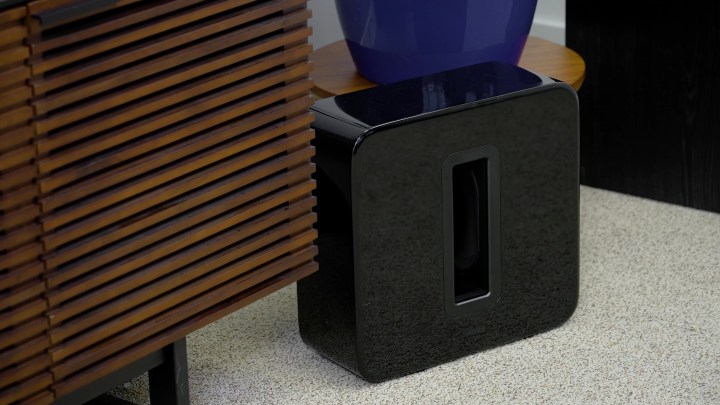
Now, as for audio fidelity or general sound quality, the Sonos system is dazzling. It really grabs a hold of you and commands your attention. And part of its dazzling effect is that it comes from relatively small and sleek speakers. It is very good sound, and I have seen folks react to it with disbelief in demo rooms. In the same way, some folks couldn’t believe Bose systems did what they did back in the 1980s and early ’90s,
The Dragon just sounds effortless and easy compared to the Sonos system. I think this is most obvious in the treble region, where the
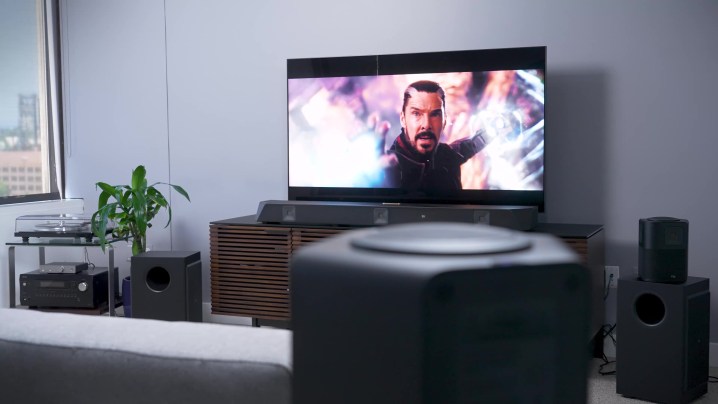
To me, it is pretty clear the Sonos uses digital signal processing to muscle its speaker drivers into sounding great, even though those drivers are in a less-than-optimal acoustic environment — and by that, I’m referring to its cabinet. The whole getting a big sound from a small package thing requires a fair amount of DSP muscling. And while the
For music listening — and by this I mean sit down and pay-attention-style music listening — I preferred Dragon by a fairly wide margin.
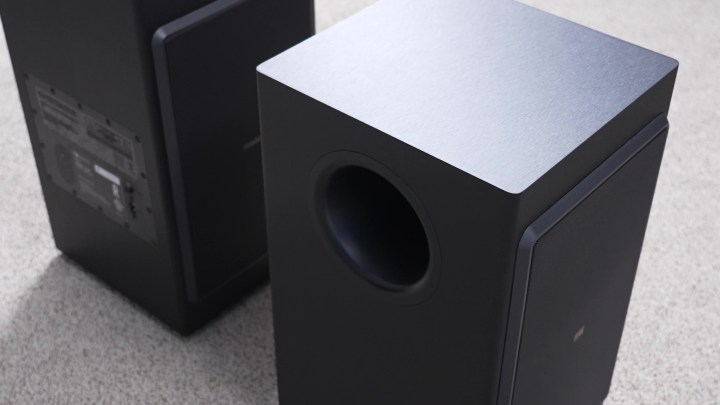
It offers better stereo separation and more natural fidelity. And there are more options in how you listen, as I mentioned earlier. You get tons of detail and texture, but it isn’t too aggressive. It exceeds at low-level listening, as well as blow-you-out-of-the-room loud listening. It just has a ton of headroom. You can dial the bass in to be just how you like it, with control over how many of the four subwoofer drivers you use, which of the four sub drivers you use, and where you place the two included subwoofer cabinets.
For movies, as I mentioned before, the Sonos pulls ahead just a tad in overall Atmos immersion — but only just. The Dragon is actually able to pull off a deeper sound field behind you, and the fidelity of those movie tracks is, to my taste, superior to that of the
The verdict
The Dragon is an enthusiast’s rig. I mean, between the fidelity, the bass control, the more refined top end, and the open and natural midrange, it just delivers more aspects of audio quality that I think audiophiles are looking for. Like I said, I just preferred the Dragon’s sound at the end of the day. You have to pay for it, but if that next-level sound quality is what you desire and you are down to pay for it, the Dragon delivers. And I found it did a great job with Atmos effects, even when ceiling reflection wasn’t possible. Oh, and if I hadn’t mentioned it enough already, the Dragon can just get bonkers loud without distortion. It is a notably more powerful system than the Sonos.
So, here’s what it comes down to for me. Here, in this studio, which you could consider to be similar to a purpose-built media room in your home, the Dragon is my top pick. If I was going to put a system in my personal living room — that’s when I might lean more toward the Sonos, just because it is less of a beast, but still offers a great experience. I mean, I try to avoid being reductive, but the Dragon is the enthusiast’s darling, whereas the
Editors' Recommendations
- You Asked: Sonos setups, 5,000 nits, and dumb TVs
- Nakamichi increases the price of its Dragon 11.4.6 soundbar
- Nakamichi’s wild Dragon 11.4.6 Dolby Atmos soundbar goes up for preorder this week
- Sonos’ new Era 100 and Era 300 wireless speakers go all-in on spatial audio and Bluetooth
- Sonos adds Dolby Atmos Music and hi-res audio support for Amazon Music




